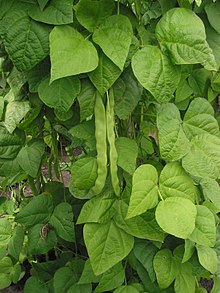| Phaseolus vulgaris | |
|---|---|

| |
A flat-podded variety of the common bean
| |
| Scientific classification | |
| Kingdom: | Plantae |
| Clade: | Tracheophytes |
| Clade: | Angiosperms |
| Clade: | Eudicots |
| Clade: | Rosids |
| Order: | Fabales |
| Family: | Fabaceae |
| Subfamily: | Faboideae |
| Genus: | Phaseolus |
| Species: | P. vulgaris
|
| Binomial name | |
| Phaseolus vulgaris | |
| Synonyms[2] | |
| |
Phaseolus vulgaris, the common bean,[3] is a herbaceous annual plant grown worldwide for its edible dry seeds or green, unripe pods. Its leaf is also occasionally used as a vegetable and the straw as fodder. Its botanical classification, along with other Phaseolus species, is as a member of the legume family, Fabaceae. Like most members of this family, common beans acquire the nitrogen they require through an association with rhizobia, which are nitrogen-fixing bacteria.
The common bean has a long history of cultivation. All wild members of the species have a climbing habit,[4][5] but many cultivars are classified either as bush beans or climbing beans, depending on their style of growth. The other major types of commercially grown beans are the runner bean (Phaseolus coccineus) and the broad bean (Vicia faba).
Beans are grown on every continent except Antarctica. In 2022, 28 million tonnes of dry common beans were produced worldwide, led by India with 23% of the total.[6]
Raw dry beans contain the toxic compound phytohaemagglutinin,[7] which can be inactivated by cooking beans for ten minutes at boiling point (100 °C, 212 °F). The U.S. Food and Drug Administration also recommends an initial soak of at least 5 hours in water which should then be discarded.[7]
- ^ Delgado-Salinas, A.; Alejandre-Iturbide, G.; Azurdia, C.; Cerén-López, J. & Contreras, A. (2020). "Phaseolus vulgaris". IUCN Red List of Threatened Species. 2020: e.T71777161A173264641. doi:10.2305/IUCN.UK.2020-2.RLTS.T71777161A173264641.en. Retrieved 11 November 2022.
- ^ "The Plant List: A Working List of All Plant Species".
- ^ Gentry, Howard Scott (1969). "Origin of the Common Bean, Phaseolus vulgaris". Economic Botany. 23 (1). New York: New York Botanical Garden Press: 55–69. doi:10.1007/BF02862972. JSTOR 4253014. S2CID 29555157.,
- ^ Phillips, R.; Rix, M. (1993). Vegetables. New York: Random House. ISBN 978-0-679-75024-6.[page needed]
- ^ Raja, Vicente; Silva, Paula L.; Holghoomi, Roghaieh; Calvo, Paco (2020-11-10). "The dynamics of plant nutation". Scientific Reports. 10 (1): 19465. Bibcode:2020NatSR..1019465R. doi:10.1038/s41598-020-76588-z. ISSN 2045-2322. PMC 7655864. PMID 33173160.
- ^ Cite error: The named reference
faowas invoked but never defined (see the help page). - ^ a b "Bad Bug Book: Handbook of Foodborne Pathogenic Microorganisms and Natural Toxins: Phytohaemagglutinin" (PDF). United States Food and Drug Administration. Archived (PDF) from the original on 2013-04-18. Retrieved 2020-04-17.
